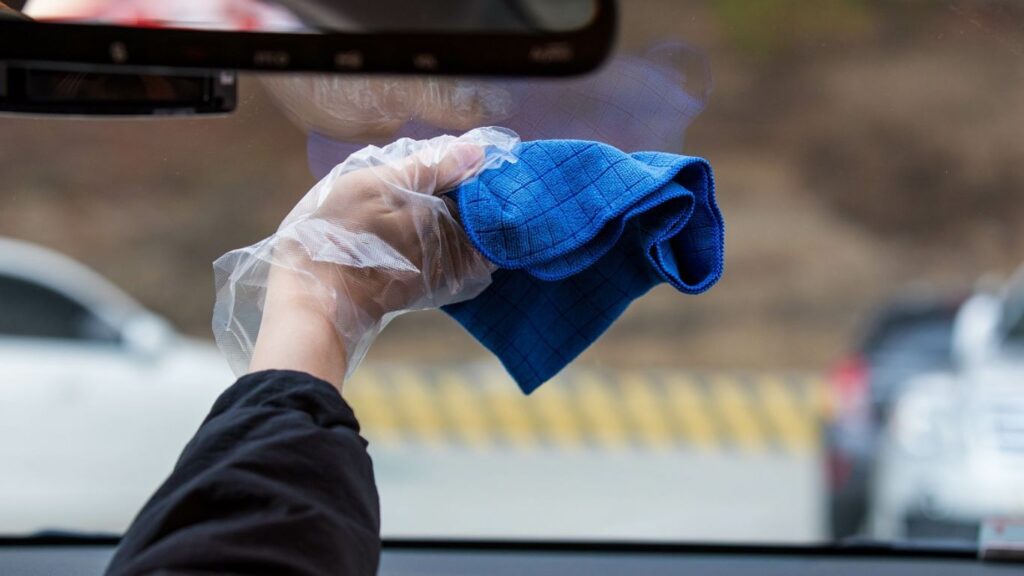Ever noticed that hazy film or streaky patches on the inside of your windshield, especially when sunlight hits it just right? You’re not alone—it’s a common issue most drivers face, and it affects more than just how your car looks. A dirty interior windshield can mess with your visibility, cause glare during night drives, and even become a safety risk over time.
In this guide, we’ll break down why your windshield gets dirty from the inside, what you should (and shouldn’t) use to clean it, and how to clean the inside of your windshield right the first time—without leaving streaks behind. Whether it’s foggy buildup from cabin air or oily residue from dashboard plastics, we’re covering the practical steps and solutions that work.
Why Does the Inside of My Windshield Get So Dirty?
Here are the most common reasons your windshield gets dirty from the inside — even when the windows are always closed:
- Off-Gassing from Interior Materials: New cars release invisible gases (VOCs) from plastics, vinyl, and adhesives. These settle on the glass and form a hazy film over time.
- Breathing and Body Moisture: Moisture from your breath and sweat adds humidity, leading to fog and residue buildup on glass surfaces.
- Touching the Glass: Fingerprints and skin oils stick to the inside of the windshield and attract dust.
- Smoking or Vaping in the Car: Smoke particles cling to glass, creating stubborn, cloudy layers that are hard to wipe off.
- Temperature Changes: Going from hot to cold (or vice versa) causes condensation inside your car, which dries and leaves marks
- High Interior Humidity: Humid environments accelerate fog and film buildup inside your vehicle.
- Dirty Air Vents and HVAC Systems: Dust, pollen, and debris from your AC or heater can settle directly on the windshield.
How to Safely and Effectively Clean the Inside of Your Windshield?
Cleaning the inside of your windshield doesn’t have to be complicated. Here’s a straightforward guide to help you achieve a clear, streak-free finish:
Recommended Tools and Materials
- Microfiber Cloths: These are gentle on glass and reduce the risk of streaks.
- Glass Cleaner: Choose an ammonia-free option to protect any window tint.
- Isopropyl Alcohol (70% or higher): Effective for cutting through greasy residues.
- White Vinegar: A natural cleaner that tackles grime effectively.
- Spray Bottle: For mixing and applying your cleaning solution.
DIY Cleaning Solution
Mix the following in a spray bottle:
- 1 part distilled water
- 1 part isopropyl alcohol
- Optional: Add a capful of white vinegar for extra cleaning power.
Step-by-Step Cleaning Process
- Initial Wipe: Use a dry microfiber cloth to remove loose dust and debris from the windshield.
- Apply Cleaning Solution: Lightly spray your DIY solution onto a clean microfiber cloth (not directly on the glass to avoid drips).
- Clean the Glass: Wipe the windshield in circular motions, starting from the top and working your way down.
- Final Buff: Use a separate dry microfiber cloth to buff the glass, eliminating any remaining streaks.
Important Tips
- Avoid Ammonia-Based Cleaners: These can damage window tints and are harsh on interior surfaces.
- Use Distilled Water: Tap water may contain minerals that leave spots or streaks.
- Protect Your Dashboard: Place a towel over the dashboard to catch any drips and prevent potential damage.
By following these steps, you can maintain a clear and safe windshield, enhancing your driving experience.
Why Is My Windshield Still Streaky After Cleaning?
If your windshield remains streaky after cleaning, consider the following common causes:
- Cleaning in Direct Sunlight: Sunlight can cause cleaning solutions to evaporate too quickly, leaving behind streaks. It’s best to clean your windshield in the shade or during cooler parts of the day.
- Using the Wrong Cloth: Paper towels or low-quality cloths can leave lint and fibers on the glass. Opt for a clean, high-quality microfiber cloth designed for glass surfaces.
- Not Drying Properly: Allowing the cleaning solution to air dry can result in streaks. After applying the cleaner, promptly wipe it off with a dry microfiber cloth to ensure a clear finish.
- Using Too Much Cleaner: Excessive amounts of cleaning solution can be difficult to wipe off completely, leading to residue and streaks. Use a minimal amount—just enough to cover the surface lightly.
- Dirty Cloths: Reusing dirty or damp cloths can reintroduce grime to the glass. Always use a fresh, clean cloth for each cleaning session.
- Residue from Previous Cleaners: Some cleaners, especially those containing ammonia, can leave residues that cause streaking. Ensure you’re using a cleaner suitable for automotive glass and free from harsh chemicals.
By addressing these factors, you can achieve a streak-free, clear windshield, enhancing visibility and driving safety.
How Often Should You Clean the Inside of Your Windshield?
Keeping the inside of your windshield clean is essential for clear visibility and safe driving. Here’s a simple guide to help you determine how often to clean it:
- General Recommendation: Clean the interior of your windshield at least once a month. This helps prevent the buildup of dust, grime, and residues that can impair visibility.
- Frequent Drivers or Urban Areas: If you drive daily, especially in cities with high pollution, consider cleaning it every two weeks. Urban environments can lead to quicker accumulation of contaminants on your windshield.
- Smokers or Pet Owners: Smoke and pet dander can leave films on the glass. In such cases, a weekly cleaning might be necessary to maintain clarity.
- Seasonal Factors:
- Summer: Open windows and increased pollen can dirty the windshield faster. Cleaning weekly during this season can be beneficial.
- Winter: Condensation and road salt can contribute to grime. Aim for a bi-weekly cleaning to keep the glass clear.
Regular cleaning not only ensures better visibility but also enhances overall driving safety.
Conclusion
A clean interior windshield isn’t just about appearance—it’s about safety. Foggy buildup, oily streaks, and airborne grime can distort visibility and make driving, especially at night, riskier than it needs to be. Following a simple cleaning routine every few weeks keeps your view crystal clear and helps you spot early signs of wear or damage on your auto glass.
But if cleaning no longer helps, and your windshield shows chips, cracks, or cloudiness that won’t go away—it might be time to consider a professional fix.
Whether you need windshield repair in Phoenix, full windshield replacement, or specialized services like RV windshield replacement and repair or truck windshield repair and replacement, it’s always best to trust a local expert. If you’re searching for an auto glass shop near you that puts safety and service first, our team is here to help.
Frequently Asked Questions
Can I use baby wipes or household wipes to clean my windshield?
While baby wipes or household cleaning wipes might seem convenient, they’re not ideal for automotive glass. Many contain moisturizers, fragrances, or alcohol derivatives that leave behind streaks or residue. Plus, they’re not designed to break down the oily film caused by off-gassing inside cars. For best results, stick to microfiber cloths and glass-safe solutions.
What’s the best time of day to clean the inside of my windshield?
The best time is during the early morning or late evening, when the glass is cool and out of direct sunlight. Cleaning during hot hours can cause your cleaning solution to evaporate quickly, leaving streaks behind. Aim for shade or a well-ventilated garage to make the job easier and more effective.
Is it safe to use a steam cleaner on the inside of a windshield?
Yes, a handheld steam cleaner can be a safe and chemical-free option to loosen up tough grime or nicotine film. Just avoid holding it too close to the glass for too long, and don’t use it near sensitive electronics like dashcams or heads-up displays. Always follow your device’s safety guidelines.
Why does my windshield fog up even after cleaning it?
Fogging isn’t always caused by dirt—it’s usually a humidity issue. If your HVAC system isn’t functioning properly, or your cabin filter is clogged, moisture can build up inside the car. This moisture condenses on cooler surfaces like the windshield. Replacing your cabin filter and using the defrost setting can help manage this better.
Can interior windshield haze cause inspection failure?
In some states or regions, visibility through the windshield is a factor during vehicle inspections. If the haze or buildup inside your windshield significantly impairs the driver’s view, it could lead to a warning or inspection failure. Keeping your glass clean is not just good practice—it could save you from an unexpected visit to the shop.





